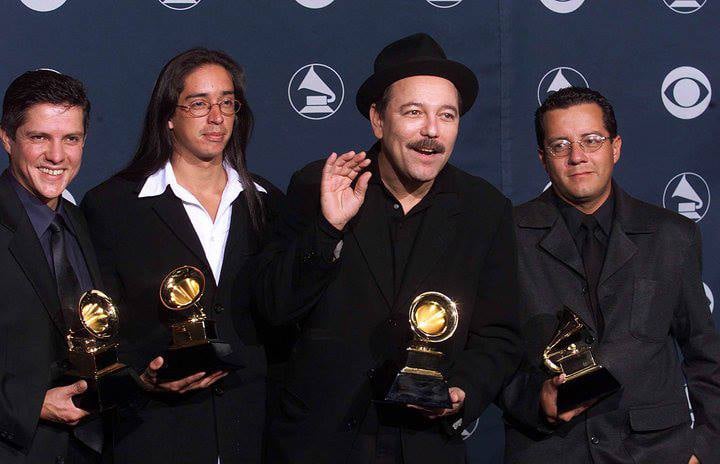1. Tiempos (2000) by Rubén Blades (Panamá) featuring Grupo Editus (Costa Rica)
This was salsa icon Rubén Blades' homecoming album, recorded in collaboration with the amazing instrumental Costa Rican band Grupo Editus and it won three Grammy Awards. It was the first truly Central American album for the Panamanian, who had spent his profesional life in New York, as a salsa artist, working with musicians mostly from Puerto Rico and Cuba. In Tiempos, Blades works with musicians close to home, in new genres. And the result was sublime - a perfect synthesis between the highly meaningful lyrics we'd grown to expect from Blades, with a new sophisticated musicality of the classically and jazz trained musicians from Grupo Editus.
The first song Vida encapsulates the ambition of a project that is literally bursting with life. The themes he touches are overwhelmingly broad: Blades clearly wants to sing about EVERYTHING, in a musical form that is beyond the constraints of salsa. Messages weave through musical threads. “If death doesn’t discriminate then neither should life” he sings...before the chorus erupts: “sueño con un mundo diferente, donde el amor nuca se acaba” and then out of the blue he cries ”que vivan los gitanos!" and " Pura vida" in tribute to his Costa Rican neighbours. Another song, Aquacero, pays tribute to the passionate warm rainfalls that bless this tropical region.
Tiempos is a perfect album, blending classical and tropical music genres, which frame the meandering, questioning lyrics. Every song is accomplished and has its place and meaning, each like a child in a family. This is a celebration of life …Blades is happy, and why shouldn’t he be? He is at the height of his powers, has returned home and has chosen the perfect words and perfect musicians to accompany this stage in his life. A stage which Blades encapsulates in the last song: "There's a time to leave, and another to return."
2. Historias (1994) by Ricardo Arjona (Guatemala)
Ricardo Arjona's Historias (1994) was a pivotal album not only for his career but also for the cultural landscape of Central America. As a Guatemalan artist, Arjona’s success with Historias gave a powerful voice to the region on the international music stage. The album resonated deeply with listeners through its compelling storytelling, blending themes of love, heartbreak, and social issues with poetic and relatable lyrics. Arjona addressed universal human experiences while also highlighting the struggles and aspirations of Central Americans, making his songs both personal and reflective of the broader societal challenges in the region. Historias was a moment of cultural pride for Central America, proving that music from the region could break boundaries, influence latin pop globally, and inspire generations of listeners with its depth and authenticity.
Historias is a career-defining success album because of its well-developed songs, the deep meaning of his songs, and the paradox of freedom and emptiness.
3. Luis Enrique – Ciclos (2009) – Nicaragua
Our personal favourite of this incredible Nicaraguan salsa singer is Luces del alma (1990) when this unlikely star exploded fresh-faced onto the Latin music scene when salsa was THE music of choice for Latin Americans. It includes the hit Date un chance, a heart rendering tune referencing the singers mother who struggled with addiction. However, twenty years later, in 2010, just when salsa was being over taken by reggaetón as the new generation's favourite genre, Luis Enrique, now in his 40s, scored a major hit with his album Ciclos, which won him a Latin Grammy. The album includes hits like Yo No Sé Mañana and helped bring salsa back to the forefront of Latin music again, back from the dead, blending the genre’s traditional sounds with contemporary influences.
Ciclos marked an extraordinary return for Luis Enrique who had been off the music scene for 9 years. With this album, he brought his traditional salsa sounds, latin pop ballads, and new digital effects. In addition, this album was produced by Sergio George (an acclaimed music producer) and came with a DVD that has footage of all the songs. Ciclos has the electric bass sounds in combination with the piano. Overall, this gives Luis Enrique's music a robust and unforgettable sound.
4. Ilusión (2016) by Gaby Moreno (Guatemala)
Gaby Moreno, a standout voice from Guatemala, has become one of the most distinctive talents in contemporary Latin music. Her album Ilusión is a captivating fusion of blues, soul, and Latin folk, highlighting her versatility and gift for storytelling. The album, which earned her a Latin Grammy nomination, is celebrated for its introspective lyrics and the warmth of her vocals. Songs like “Fronteras” explore the immigrant experience, a subject close to her heart, while “Se Apagó” delves into deep emotional reflection. Ilusión is a soul vibrating Album that is country and rock and roll inspired with Latin Alternative sounds. Her lyrics not only touch on love, but the immigrant experience and the violence that women experience around the world. With Ilusión, Moreno demonstrates that her artistry knows no boundaries, crossing both cultural and musical lines. Gaby Moreno will be in London this Oct 17th and 18th at Pizza Express Jazz Club (Soho).
5. Kamikaze (1999) by Los Rabanes – Panamá
Los Rabanes, one of Panama's most iconic rock bands, electrified the Latin American music scene with their energetic fusion of punk, ska, and rock en español. Kamikaze embodies the band's playful yet rebellious spirit, featuring tracks like "Señorita a mí me gusta su style" and “Perfidia.” The album is a dynamic mix of humor, social commentary, and an irresistible danceable energy.
Señorita a mí me gusta su style became an anthem for everyone who loved ska and alternative Latin Rock. In addition tracks like Reggae Punk Panama incorporated cultural references and diverse musical styles. Winning the Latin Grammy Award for Best Rock Album, Kamikaze solidified Los Rabanes’ status as one of Central America’s most influential and groundbreaking rock bands.
Los Rabanes brought Central American music to a global audience. Their playful yet socially aware lyrics gave them a loyal fan base far beyond Panama.
6. Tiempos de Cambio (2021) by Lilo Sánchez y Balboa (Panamá)
Lilo Sánchez y Balboa delivered a powerful and musically diverse album with Tiempos de Cambio, released in 2021. The album fuses Afro-Caribbean rhythms, jazz, reggae, and salsa, while tackling themes of identity, history, and social transformation. Songs like “Revolución Sonora” showcase the duo’s dedication to using music as a platform for reflection and change. More than just a collection of tracks, Tiempos de Cambio is a commentary on the shifting political and social dynamics of Latin America. This album firmly establishes Lilo Sánchez y Balboa as prominent voices in Panama's contemporary music scene.
7. Son tus perjúmenes mujer (1977) Carlos Mejía Godoy (Nicaragua)
Carlos Mejía Godoy is one of Nicaragua’s most beloved folk musicians, and his 1977 album Son tus perjúmenes mujer stands as a cultural landmark. Mejía Godoy, known for his revolutionary songs that supported the Sandinista movement, shifted to a more lighthearted tone with this album. The title track, a humorous and playful ode to a woman’s perfume, has become a classic in Nicaraguan music. Despite its lighter mood, the album reflects the rich folk traditions of Nicaragua, blending indigenous, Spanish, and African influences. Son tus perjúmenes mujer showcases Mejía Godoy’s versatility and deep connection to the country’s cultural heritage.
8. Canto Popular (2006) Perrozompopo (Nicaragua)
Perrozompopo, the stage name of Nicaraguan musician Ramón Mejía, is known for his politically charged lyrics and fusion of folk, rock, and reggae. His 2006 album Canto Popular is a powerful reflection on the social and political struggles of Nicaragua, touching on themes of inequality, justice, and resistance. Tracks like “Voces” and “Esperanza” express the frustrations and hopes of a generation seeking change. Perrozompopo’s raw, passionate voice and socially conscious lyrics make Canto Popular a compelling work that resonates deeply with listeners. The album’s fusion of genres and its strong message of activism cement its place among the best music to come out of Nicaragua.
9. Alux Nahual (1981) Alux Nahual – Guatemala
One of the most iconic rock bands from Guatemala, Alux Nahual’s self-titled debut album fused rock with classical music and Latin rhythms. Tracks like “Héroe” and “La Fábula del Grillo y el Mar” became anthems of the Latin rock movement, solidifying the band’s place in the history of Central American music.
10. Movimiento Cadera (1991): The Birth of Reggaetón El General (Panama)
One of the most influential albums in Latin music history, Movimiento Cadera (1991) by El General, revolutionized the music scene and laid the foundation for what would later become reggaetón. Hailing from Panama, El General (Edgardo Franco) was one of the first artists to blend reggae rhythms with Latin influences, creating a fresh sound that resonated with audiences across Central America and the Caribbean. His music fused dancehall, soca, and hip-hop with Spanish lyrics, a combination that was groundbreaking at the time.

















